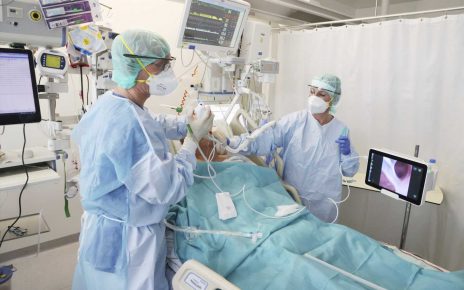
The Biden administration announced this week that it will take new measures to expand access to Paxlovid, the first medication developed to treat COVID-19. The White House plans to nearly double the number of places that carry the drug, help educate providers and the public, and create more Test-to-Treat centers, where patients can get tested and pick up the drug in one visit.
Paxlovid—a protease inhibitor that prevents the coronavirus from maturing into a full-blown infection—consists of a five-day treatment regimen, and is meant to be started within five days of the initial onset of symptoms. And while there are downsides to taking the drug, including potential drug interactions and interference with kidney function, it’s proven to be incredibly effective, helping to reduce hospitalizations among unvaccinated people by up to 90%.
As COVID-19 cases start to rise in the U.S. again, the new measures could be critical in helping to get the life-saving drug in the hands of those who are at the highest risk of serious illness. But experts wonder if the plan will be enough to combat the pre-existing barriers to accessing the medicine, and whether drug-maker Pfizer’s distribution strategy could leave the rest of the world in the lurch.
Raising awareness about the drug would be a welcome step, according to Brandon Dionne, associate clinical professor at Northeastern’s Department of Pharmacy and Health Systems Sciences. Currently, providers are hesitant to prescribe Paxlovid, and patients might not even know that it exists. Dionne says that could be in part due to a faulty rollout strategy. When the drug was first authorized for use in December 2021, the supply was low, and it was reserved for only the most at-risk patients.
“We were trying to prioritize patients,” Dionne says. “And in some ways that then backfired because there wasn’t this big fanfare rollout.”
Now, even though Paxlovid is more widely available, its reputation is one of low availability, causing doctors to under prescribe it.
“Now that there’s more of a supply, we just need to make people aware,” Dionne says.
But a lack of awareness is only part of the problem when it comes to connecting people to treatment. Paxlovid is only available via prescription, after a doctor verifies that the patient has tested positive, is part of a high-risk population, and will not experience adverse side effects. For those who don’t have health insurance or a primary care physician, this presents a significant barrier, Dionne says. Plus, even if a patient does have insurance and a doctor, it can be difficult for doctors to know who carries the drug.
“Let’s say that as a physician, you wanted to provide Paxlovid for your patient. You don’t even necessarily know which pharmacy to send the prescription to,” Dionne says. “That was probably the biggest limiting factor, is just confusion about the process.”
That’s why Biden’s plan to expand the Test-to-Treat program is important. Currently, there are 2,200 sites nationwide where patients can get tested and treated at the same clinic, usually at a pharmacy such as CVS. For those who don’t have a PCP or insurance, those sites can be the best bet for getting Paxlovid.
Expanding this program would be a welcome step, says Northeastern law professor Brook Baker. However, “that still leaves a lot of people uncovered who aren’t near those kinds of facilities,” Baker says.
Wyoming and North Dakota, for example, each have one Test-to-Treat location, not including military facilities, and South Dakota currently has zero. These “pharmacy deserts” will likely leave some people without access even after an expansion of the program. Both Dionne and Baker agree that creating prescriptive authority for pharmacists would be a key step toward resolving this issue, especially as the public likely won’t ever see Paxlovid sold over-the-counter due to the risk of drug interactions.
Plus, while Biden works to make Paxlovid more readily available in the U.S., Baker says, the problem of inaccessibility is much worse globally due to Pfizer’s monopoly over the drug. Currently, Pfizer is the sole producer of the drug. While it has licensed 95 countries to produce generic Paxlovid, Baker says these companies won’t be able to sell until the end of the year.
“Everyone’s turning to Pfizer as the sole source of supply,” Baker says.
But according to Baker, the company hasn’t done nearly enough to ensure that countries have equal access to the drug, instead prioritizing the richest nations. “[Pfizer] has already pre-committed the first half of 2022 production, which was only going to be 30 million courses of treatment, to rich countries,” he said. While the Global Fund has agreed to purchase 10 million courses from Pfizer, and Pfizer made an agreement with UNICEF to secure 4 million courses to low- and middle-income countries, representatives for both organizations say that’s inadequate.
“Pfizer has not done nearly enough to ensure affordability and adequate supplies in low- and middle-income countries,” Baker says. “It’s prioritized sales at higher prices to rich countries first.”
The unequal distribution of the drug adds insult to injury for unvaccinated people around the world who are at the greatest risk of experiencing the adverse effects of COVID-19.
“In many respects, the people in the world who suffered inadequate access to vaccines are the populations that may most be in need of therapies,” Baker says. “And if we’re not prioritizing their access … then those patients are at a much higher risk. In some sense, the risk of serious disease is quite substantial in the countries that are underserved at this time.”
Pfizer is also facing accusations of blocking Paxlovid access from studies that look at how it interacts with other drugs, something that Baker says is unacceptable. “They should clearly support ongoing innovation to find effective treatment regiments,” he says.
Source: Read Full Article



